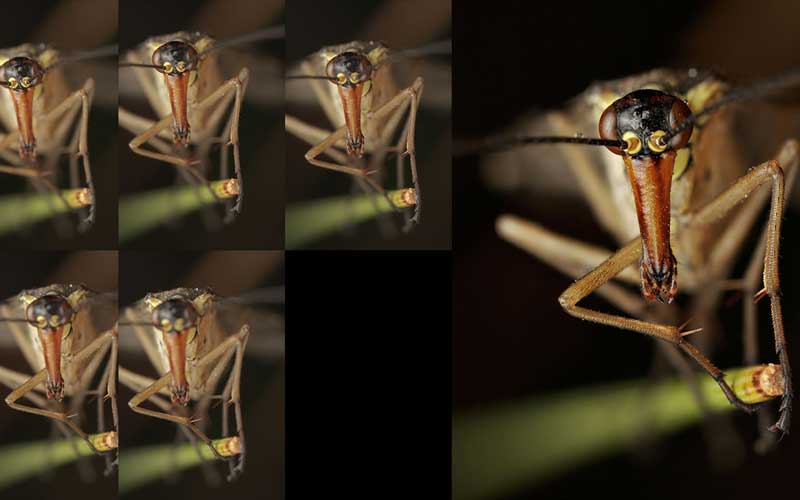

- #Photo focus stacking how to#
- #Photo focus stacking manual#
- #Photo focus stacking software#
- #Photo focus stacking iso#
It’s fully automated, so all you have to do is press the shutter, and it will do the rest. So if you want more precision, you need to use Helicon Soft. The problem with Photoshop is that it produces inconsistent results, especially if you focus manually. As you can see, every part of the toy car is sharp. Here is my final image after some cropping and increasing brightness. Photoshop will find the sharpest parts on each photo and mask them. You can bypass this, and crop the image later. Make sure to select Seamless Tones and Colors.Ĭontent-Aware Fill Transparent Areas will fill parts of the images that lack information. Go to Edit>Auto-Blend Layers. You need to decide between Panorama and Stack Images. Select the first image, hold down Shift, and click on the last picture. In the Layers Panel, you will see all the images as layers. After clicking OK, Photoshop will place all of your images into layers. Doing so allows Photoshop to auto-align the images for you. With your files added, make sure you check Attempt to Automatically Align Source Images. Go to File>Scripts>Load Files into Stack. But any version from Photoshop CS6 will allow you to do this. NB: It is always better to have the most updated version of Photoshop.
#Photo focus stacking how to#
Here, we will show you how to do it in Photoshop.
#Photo focus stacking software#
To edit your images, you will need Photoshop or dedicated software such as Helicon Soft. The red circle indicates their current focal plane.

Here are the images I’ll be working with for this demonstration.

But be patient because the result will be worth your time. NB: Between 6 and 30 images are best for optimal sharpness.ĭepending on what you are photographing, the entire process can take 5 minutes to upwards of 30 mins. Use the below images as a reference guide. Step 10. Repeat steps 5 and 6 until you have the entire subject covered. Don’t move the camera, tripod, or any other settings, or you’ll get inconsistent results. Keep doing taking photos until you reach the tip of the object you want to stay sharp. Step 9. Use the live view to set the focal point on the next section was blurry in the previous shot. Step 8. Use the focus ring to ensure optimal sharpness. Use the camera zoom (+ symbol – don’t zoom with the lens) to preview the focus. Step 7. The focal point needs to be on the closest part of your subject. This will help you focus on the object easier. Slow shutter speed is not a problem here (that’s why we have the tripod, among other things).
#Photo focus stacking iso#
Step 4. Your ISO should be as low as possible.
#Photo focus stacking manual#
Your camera needs to be on Manual mode (M). Your subject needs to extend away from you/the camera somewhat. Step 2. Compose your image by framing your subject. So how do you take focus stacking photos? Let’s go through all the steps below. How to Focus Stack: Photographing the Subject So focus stacking is the only way to create a tack sharp image. But doing so will also create a shallow depth of field. You might need a wider aperture to let in more light. If you go beyond that, your image will start to lose sharpness as well.Īpart from the DOF, you also need to consider the light conditions. If you’re going for ultimate detail, you’re limited to apertures below ~ f/11. Why can’t you simply use a smaller aperture (f/16) to create a deeper depth of field? Well, a smaller aperture would, indeed, place much more of the subject in focus.īut if you’re shooting at a close distance, even the narrowest aperture is not enough to get everything sharp.ĭiffraction might also be of concern. If you’re using a macro lens, the DOF will still be shallow, even if you set your aperture to f/8. Anything above and below these values, and you may start finding aberrations. But this technique is also popular in product and still-life photography, among others.Ĭhoose the Ideal Aperture for Focus Stackingįor stacking photographs, the ideal aperture is around f/5.6 or f/8 because they have just the right depth of field. This process results in a photo that is sharp from the foreground to the background.įocus stacking is common in macro photography, landscape, and architecture images can benefit from focus stacking. So what is stacking, exactly? In simplest terms, it’s a technique that combines several images of an object shot at various focus points. In other words, only a section of the object you’re photographing will be sharp.īut what if you want the whole object to look sharp? Then that’s where focus stacking comes in. When you use a wide aperture (such as f/2.8) at a short working distance, the depth of field (DOF) will be extremely shallow. Buy from Unavailable What Does Focus Stacking Mean?


 0 kommentar(er)
0 kommentar(er)
